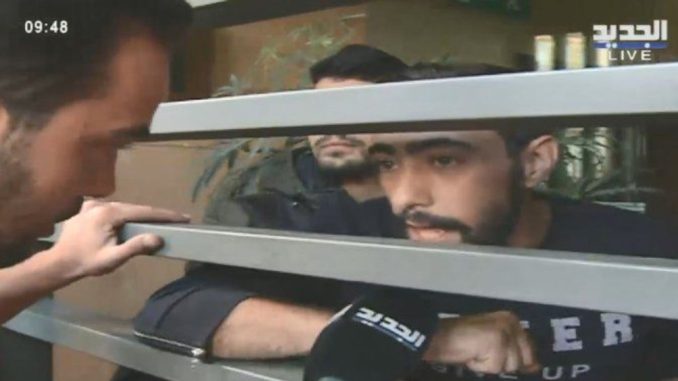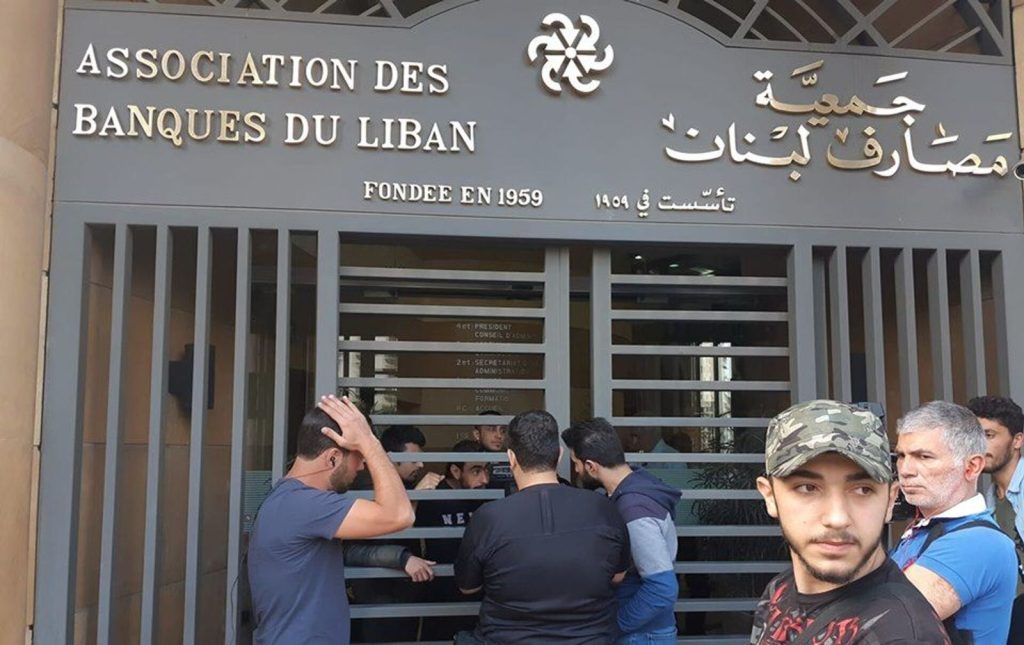
By Khoder Al Anwar – LIS Líbano
“Comrade, tomorrow we will have breakfast”
This phrase was the password that alerts some comrades in the movement to prepare to take a ministry or a private institution and deliver a specific political speech, as it happened when we occupied the Association of Banks, the Bank of Lebanon or the Ministry of Environment… It was not the importance in the occupied center, nor how dangerous it was, as much as it was in the struggle against the structure of the Lebanese system.

But in the end, fighting the structure of the regime required more than a “dream” and more than a group of young people. The struggle against the regime requires a broader revolutionary framework that is politically and organizationally stronger. The last time was not a “breakfast” but a last supper.
In the last statement we presented the comrades with a conscious and clear example of dissolving their framework and moving forward. The Youth movement issued its last communiqué in which it announced its dissolution, transparently explaining two main problems. The first is the organized power of the enemy, i.e. the Lebanese regime, and the second is subjective and translates into thought, policy and organization.
At the end of the declaration, the movement called on comrades who agreed on a similar vision to form its new framework and participate in the confrontation. This is actually what a group that withdrew from the movement months before the dissolution started to do, and we can call it the “international section in Lebanon”.
Why the “International Section in Lebanon” and how do we see the conflict and the methods of confrontation?
The popular uprising in Lebanon in 2019 played an important role in forming the core of this group, from its intellectual vision to its political proposals. It should be noted that the uprising was not the only reason, but rather it is a cumulative process that may have started from the very first moment of the formation of the Youth Movement for Change. The last statement touched on this point. The movement was established carrying different intellectual currents, and at each stage, especially after the loss of momentum of the popular movements, such as the stage that followed the popular movement in 2015, and the stage that followed the uprising of 2019 and the pandemic, conflicts were brewing between intellectual currents and a current that adopts a Maoist approach that calls itself “the left of the resistance” withdrew.
On the other hand, the pace of intellectual and political discussions decreased during the popular outbursts and the pace of unity and commitment in organizing increased. The reason for this is particularly due to the fact that the framework of the movement was born in the streets during the 2015 movements, and its polarization, demonstrations and collective participation peaked during the outburst. Therefore, it can be said that the framework of the youth movement from its foundation until its dissolution was dialectically linked to the street movement, but the crisis was in how to develop the work with the internal organizational structure.
As a result of weak capacities, the cumulative process of transforming this framework into a revolutionary party that could lead the confrontation was interrupted. From its constitution until today, the “international section in Lebanon” within the movement has always tried to break this cycle, developing action plans and education programs, especially the plan that was put forward in 2018 with the aim of building the historical bloc derived from Gramsci.
In that plan, an effort was made that began with street movements in which private companies, plundering institutions, banks and embassies of governments that dominate political decision making in Lebanon were confronted. These movements led to the arrest of a number of comrades, which contributed to increasing the intensity of polarization and education at a time when the pace of popular movements was almost non-existent, and it should be noted that this was the first time in the history of the Youth Movement for Change that the number of its members increased in isolation from the increase in the drive of popular movements in the street. These attempts continued according to the established plan until the popular uprising, in which the movement emerged as a referent, as a result of the organization’s long experience with demonstrations and tactical movements.
However, in the midst of the uprising, the discussions within the movement began to announce the emergence of two ideological currents.
The first current starts from the theory of the class struggle to analyze the structure of the system, the form of the State, the Lebanese and international system, the imperial hegemony and the regional powers, and to establish its political proposals accordingly.
The second current starts from the anti-US position on the basis of the contradiction based on the geopolitical conflicts in the region to establish its discourse and political positioning, bypassing the theory of class struggle, which is one of the foundations of Marxism in analysis.
The first current: we consider that its development is related to the experience of the implementation of the Action Plan of 2018, which was exposed more than ever to the tools of Marxist analysis; from Gramsi to the concept of the Permanent Revolution to try to understand the structure of the national system and its link with the global system on the basis of the equivalent development of capitalism.
On the other hand, it began to communicate with Marxist forces using the same tools of analysis to form part of an international to fight the global system.
All these factors, as well as the Lebanese and Middle Eastern political events and the development of the uprising, were fundamental factors in giving birth to this current.
While the second current decided to resolve its position in the “resistance “1 as a result of the influence of the political events in the Middle East, and, therefore, turned to adopting the discourse of the Secretary General of Hezbollah and linking the crisis to the idea of the US blockade of Lebanon.
The international section in Lebanon tried to raise intellectual debates to end the difference. The result of the internal intellectual debate resulted in the understanding of the nature of the system which is formed of 3 main poles, the ruling militias of the political power, the financial tyranny and the religious authority.
The Bank of Lebanon plays the role of securing financial interests for this alliance.
However, in every political event, we return to the same vortex, especially with the emergence of any right-wing discourse against Hezbollah’s weapons.
Here, we know that the right wing is our enemy, but those on the opposite side, “the armed ones”, are also right wing to us.
The two fronts form the system that supports and protects the rich class, and we saw this on more than one occasion, especially in the recent elections in Hezbollah’s alliance with the CEO of the “Resources Bank”, Marwan Khair al-Din, and the support of the Chairman of the Board of Directors of the Association of Banks, Salim Sfeir, to the list of “the Lebanese forces.”2
All these factors made the two currents contradictory. As the discussion sessions continued, the international section has begun to develop a plan of action to form a revolutionary framework in a larger step of the Youth Movement itself, to communicate with independent Marxists. However, the explosion between the two currents was closer and particularly after the start of a new round of debate on the Russian imperialist war.
The decision of the withdrawal of the international section in Lebanon and dissolving the Youth Movement for Change was a natural result of all these conflicts.
The international section participated in the establishment of the Youth Movement in 2015 and all its attempts were in converting the framework of the Movement into a party, because we are sure of the importance of forming a revolutionary party.
We have already published on the website of the International Socialist League a document on the next phase and the broad directions of the Action Plan established by our section, which are 3 key lines: a grouping for the unemployed, a feminist framework and a student framework.
Why is this form of organization and what are the characteristics of the party?
Organizing the unemployed: this assembly is not only trying to organize those without work, but its project is divided into two major phases, temporary and strategic. The Assembly seeks to fight to improve the economic and social conditions for those without work, or limited workers, through implementing a “social income” that is ensured by the State as unemployment compensation, housing, public health, transportation, energy, education. Strategically, this “social income” program will change the structure of society and transform an individual’s loyalty to traditional parties to the concept of citizens receiving social services from the state.
Feminist framework: if the crisis attacked society in a savage way, women suffered twice as much.
Women suffer economic exploitation at work and patriarchal discrimination.
In most feminist organizations and movements in Lebanon and the Middle East, liberalism dominates.
Marxist feminist movements were facing difficulties in organizing themselves. Therefore, it is necessary to start creating a feminist front that defends the Lebanese working woman in her workplace and at the same time break the male chauvinist norms that dominates in the country.
Student framework: no change can be built and achieved without young people, specifically the students of the Lebanese University.
This framework, therefore, has two important battles: the first is the defense of the existence of the National University, and the second is to change the educational curricula to achieve unified scientific and national curricula. These 3 frameworks constitute the Revolutionary Party, which enjoys certain characteristics that will be part of it;
1. Clarity of vision: the Marxist Party depends on Marxist tools of analysis in its struggle. The theory of class conflict is the main corner in the vision and formulation of its program and objectives. Objective to overcome capitalism with all its forms and tools to a system of production that ensures a dignified life for all the people. The party also envisions its existence only in Lebanon, but it is directed towards launching the socialism of the Middle East that is launched from its social, cultural, economic and political reality, and takes into account its circumstances and possibilities.
2. Not participants, but militants: the party will build its columns on the basis of revolutionary militants who leave personal interests behind and work to achieve and build socialism. Militants who are conscious of the immense task they have and the need for change in all its forms.
3. Internationalism: it is not possible to struggle to achieve welfare in a society without understanding the structure of the world order. The global capitalist system in its development is based on the exploitation and wealth of the peoples. We can clearly see that capitalism does not manage to overcome its crisis since 2008, which alerts us to the barbarism and destruction. Since capitalism is a global system, this system must be confronted internationally to free the peoples from its chain.
Change has become an urgent necessity and organization is an important medium. Thus, we call all of the comrades that believe in the organizing struggle as a tool for change to participate in the creation of a free world and a happy people.
1. In Lebanon, “resistance left” refers to the left that supports Hezbollah.
2. The Lebanese Forces is a religious Christian party that separated from Kataeb Party, which was a main pole in the Lebanese civil war. To this day, they defend the massacres under the discourse that they were “necessary” for the sovereignty of the nation.








